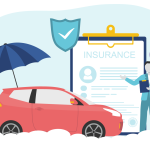6 Frequently Asked Questions About Secondary Driver Insurance
May 1, 2023

As a driver, it’s probably not unusual for you to lend out your vehicle from time to time to a friend or a family member in need. Maybe your friend’s car is in the repair shop, or your relatives need help moving across town, or your sibling simply wants to run an errand.
But when it comes to your Auto Insurance, will anyone who borrows your vehicle automatically be covered in case of an incident? What about the other adults who live with you, like your spouse or your parents? What about your teenage child who just got their driver’s license?

In this blog, we’ll explain everything you need to know about adding another driver to your Auto Insurance policy—the difference between a primary and secondary driver, who should and shouldn’t be added, how it can affect your premium, and how you can save on the cost.
What’s a primary driver?
Every vehicle is assigned one primary driver for insurance purposes. The primary driver is the person who uses that particular vehicle the most, and the base insurance premium will be calculated according to their demographic factors and driving history.
Although the primary driver is usually the person who owns or leases the car, this doesn’t always have to be the case. Whoever uses a car more frequently than anyone else in the household should be assigned as the primary driver of that car. For example, you might own a car that your child uses more regularly, making them the primary driver of that car.
What’s a secondary or occasional driver?
If you share your vehicle with others, you’ll need to add additional drivers to your insurance policy. A secondary driver, also referred to as an occasional driver, is a role assigned to someone who regularly uses a car from time to time, but less often than the primary driver of that car.
Secondary or occasional drivers are typically a member of the primary driver’s household, whether that’s a partner, child, parent, or roommate. For instance, if you use the car to commute to work every day, you would be the primary driver—and your spouse who drives it for errands or leisure trips once or twice a week would be the secondary driver.
Who needs to be added to my Auto Insurance?
As a rule of thumb, any licensed driver who uses your car on a regular basis or lives in your household should be named as a secondary or occasional driver on your Auto Insurance policy. This could apply to a family member, roommate, or friend who borrows your car regularly—or even a nanny or personal care worker who uses your car to perform their daily duties.
Keeping your insurer updated with the most accurate information will guarantee that you’ll be covered in case anything should happen to your vehicle. If you have any questions or concerns about your unique situation, contact your broker for a tailored recommendation.
RELATED: Collision vs. Comprehensive Insurance: What’s the Difference?
Who DOESN’T need to be added to my Auto Insurance?
Only drivers that are expected to use your car on a regular basis need to be added to your Auto Insurance policy. That means you don’t need to add your friend who needs your car for a one-time emergency, or your relatives who are visiting from out of town and want to borrow your car for sightseeing.
Lending your car out to a trusted individual that’s not listed on your policy every once in a while is fine; they would be considered incidental drivers. But keep in mind: while they’re borrowing your car, they’re also essentially borrowing your coverage—and if they happen to get into an accident, it may impact your insurance.
Additionally, your teenage child who only has their learner’s permit doesn’t need to be added to your Auto Insurance policy just yet. But they will once they receive their probationary driver’s license (G2 in Ontario, class varies by province).
How can I save on secondary driver insurance?
If possible, choose your secondary driver wisely. Adding a reckless or inexperienced driver, like a teenager or someone with a poor driving record will likely cause your insurance costs to spike. The cost difference between adding a low-risk driver compared to a high-risk driver ranges up to hundreds of dollars per month!
Insurance companies also offer a variety of little-known discounts that you could be eligible for, and it won’t hurt to ask your provider! Check out our blog on The Top 17 Auto Insurance Discounts Revealed to learn more—you never know how much you could be saving.
A great way to make sure you’re getting the best bang for your buck is to shop around and compare quotes from different insurance companies. This is because each insurer has its own way of calculating risk and determining your premium costs—they also offer different coverage options at different price points, so be wary of compromising on your coverage needs while you’re searching for the best deal.
Don’t have the time to shop around, or simply need more guidance? Let an independent insurance broker—like PROLINK—do all the heavy lifting for you. We’ll offer personalized advice and survey the market on your behalf to make sure you’re getting the best value for your money. With over 40 years in business and access to over 30 insurers, you can count on PROLINK to guide you to the right coverage from the right insurer at the right price.
To learn more, connect with PROLINK today!
PROLINK’s blog posts are general in nature. They do not take into account your personal objectives or financial situation and are not a substitute for professional advice. The specific terms of your policy will always apply. We bear no responsibility for the accuracy, legality, or timeliness of any external content.




